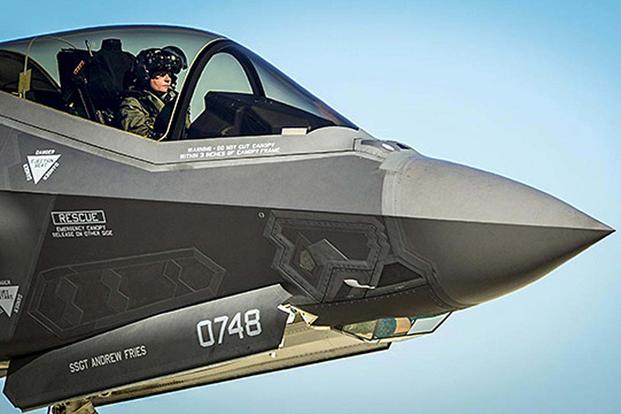Lockheed Martin Corp. has chosen Raytheon Co. to make the F-35 Joint Strike Fighter's next-generation distributed aperture system (DAS), a key sensor that allows an F-35 pilot to see a 360-degree image of the surrounding environment.
The technology "collects and sends high-resolution imagery to the pilot's helmet from six infrared cameras mounted around the aircraft" and can track threats such as surface-to-air missiles or air-to-air missiles from any angle, day or night, for various operations, Lockheed said in a statement Wednesday.
The system essentially enables the pilot to "see through" the plane, projecting an image of whatever lies beyond the aircraft via the complex camera system.
The fused imagery is projected within the pilot's helmet-mounted display (HMD), made by Elbit Systems and Rockwell Collins.
The DAS situational awareness system was previously manufactured by Northrop Grumman, known as the AN/AAQ-37. Northrop chose not to bid on the follow-on system, saying it was not an "attractive business opportunity," according to Defense News.
Related content:
- New Precision Weapon Allows F-35C to Destroy Targets in Stealth Mode
- DoD Begins Accepting F-35 Fighters After Corrosion Issue
- New Air Force Acquisitions Chief Aims to Rid F-35 of Software Glitches
Lockheed said the system -- which will be integrated first into its Lot 15 aircraft batch and expected to begin deliveries in 2023 -- is roughly $3 billion cheaper in total costs over the life of the DAS program.
"The supply chain competition for the next-generation F-35 Distributed Aperture System resulted in significant cost savings, reliability and performance improvements," said Greg Ulmer, Lockheed Martin vice president and general manager of the F-35 program, in a statement.
"We are aggressively pursuing cost reduction across the F-35 enterprise, and this initiative is a clear demonstration of our unrelenting commitment to reduce costs and deliver transformational capabilities for the warfighter," he added.
Lockheed projects Raytheon's system could save the Pentagon more than 50 percent in operations and sustainment costs.
"Raytheon's solution delivers next-generation capability for the fifth-generation F-35," said Roy Azevedo, vice president of intelligence, surveillance and reconnaissance systems at Raytheon Space and Airborne Systems. "Our focus is on providing pilots every tactical advantage imaginable while ensuring taxpayers receive the best value possible."
Lockheed did not disclose the award amount for the contract.
Raytheon is also working on a stealthy weapon for the Joint Strike Fighter.
In April, Raytheon said it had integrated the 1,000-pound Joint Standoff Weapon version C precision air-to-ground weapon, known as JSOW-C, during a developmental test in the U.S. Navy's version of the F-35.
Once it's declared combat ready, the F-35 will be able to penetrate targets in total stealth mode since JSOW-C -- carried internally in the weapons bay -- is also configured with low-observable technology.
-- Oriana Pawlyk can be reached at oriana.pawlyk@military.com. Follow her on Twitter at @Oriana0214.










